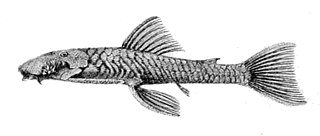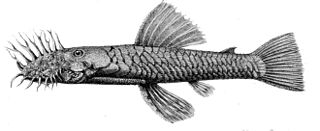
Ancistrus is a genus of nocturnal freshwater fish in the family Loricariidae of order Siluriformes, native to freshwater habitats in South America and Panama. Fish of this genus are common in the aquarium trade where they are known as bushynose or bristlenose catfish. In the aquarium hobby they are often referred to as bushynose or bristlenose plecos instead, but this may lead to confusion as "pleco" usually is used for Hypostomus plecostomus and its allies and is often used as a catchall term for any loricariids remotely resembling that species.

Ancistrus caucanus is a species of catfish in the family Loricariidae. It is native to South America, where it was at one point thought to occur in the Cauca River basin in Colombia, for which it is named, although subsequent research suggested in 2013 that it is actually native to the Magdalena River basin, whereas its congener Ancistrus vericaucanus is the species native to the Cauca. The species reaches 5.2 cm SL. It is not to be confused with the similarly named species Lasiancistrus caucanus.
Ancistrus macrophthalmus is a species of catfish in the family Loricariidae. It is native to South America, specifically found in the Orinoco River and its lower tributaries in Venezuela. The species reaches 7.9 cm (3.1 in) SL. It is occasionally seen in the aquarium trade, where it is one of multiple species sometimes referred to as "medusa plecos".
Ancistrus parecis is a species of catfish in the family Loricariidae. It is native to South America, where it occurs in the Tapajós River basin in Brazil. Its specific epithet refers to the Parecis Plateau, where the type specimen was collected. The species reaches 6 cm (2.4 in) SL.

Ancistrus greeni is a species of catfish in the family Loricariidae. It is native to South America, where it occurs in the Madre de Dios River and Inambari River basins in Peru. The species reaches 6.5 cm in total length.
Ancistrus saudades is a species of catfish in the family Loricariidae. It is native to South America, where it occurs in the basins of the Takutu River, the Ventuari River, the Caroní River, and the Caura River in Guyana, Venezuela, and Brazil. The species reaches at least 10.75 cm (4.23 in) SL and was described in 2019 by Lesley S. de Souza of the Field Museum of Natural History, Donald C. Taphorn of the Royal Ontario Museum, and Jonathan Armbruster of Auburn University alongside five other species of Ancistrus.

Ancistrus montanus is a species of catfish in the family Loricariidae. It is native to South America, where it occurs in high-altitude freshwater environments, with the type specimen being collected from an elevation of around 457 m, in the Beni River basin in the upper Madeira River drainage in Bolivia. The species reaches 9.2 cm SL.
Ancistrus brevifilis is a species of catfish in the family Loricariidae. It is a freshwater fish native to South America, where it occurs in the Tuy River basin in Venezuela. The species reaches 11.8 cm SL.
Ancistrus brevipinnis is a species of catfish in the family Loricariidae. It is a freshwater fish native to South America, where it occurs in the Lagoa dos Patos basin in Brazil. The species reaches 10.7 cm SL.
Ancistrus damasceni is a species of catfish in the family Loricariidae. It is native to South America, where it occurs in the upper Parnaíba River basin in Brazil. The species reaches 6.5 cm SL.
Ancistrus dubius is a species of catfish in the family Loricariidae. It is native to South America, where it occurs in the basins of the Amazon River, the Paraná River, and the Paraguay River. The species reaches 12.6 cm SL.
Ancistrus heterorhynchus is a species of catfish in the family Loricariidae. It is native to South America, where it occurs in the Inambari River basin, which is part of the Madre de Dios River drainage in Peru. The species reaches 6.3 cm SL and is known to inhabit high-altitude areas.
Ancistrus lineolatus, also known as the Bristlenose Catfish is a species of catfish in the family Loricariidae. It is native to South America, where it occurs in the Orteguaza River basin, which is part of the Japurá River drainage in Colombia.
Ancistrus malacops is a species of catfish in the family Loricariidae. It is a freshwater fish native to South America, where it occurs in the Ampiyacu River basin in Peru. FishBase states that the species reaches 7.7 cm SL, although larger specimens, including one of 11.78 cm SL from the Gustavo Orcés V. Natural History Museum in Quito, Ecuador, are known.
Ancistrus maracasae is a species of catfish in the family Loricariidae. It is a freshwater fish native to the Caribbean, where it occurs in the basin of the Maracas River, which is a major tributary of the Caroni River in Trinidad and Tobago, indicating that it is endemic to the island of Trinidad. The species reaches 8.3 cm SL.
Ancistrus megalostomus is a species of catfish in the family Loricariidae. It is native to South America, where it occurs in the Beni River basin, which is part of the Madeira River drainage in Bolivia. The species reaches 8.3 cm SL and is noted to inhabit high-altitude environments.
Ancistrus reisi is a species of catfish in the family Loricariidae. It is a freshwater fish native to South America, where it is known to occur in small rivers in the state of Tocantins in Brazil. The species reaches 6.1 cm SL and is distinguished from most members of the genus by the absence of an adipose fin, which for this species is replaced by a series of unpaired platelets that form a low crest.
Ancistrus trinitatis is a dubious species of catfish in the family Loricariidae. It is known only from the Caribbean, where it occurs in freshwater environments on the island of Trinidad in Trinidad and Tobago. This species is of uncertain validity, as Theodore Gill referred to the type material in 1858 as Ancistrus guacharote and it was later described by Albert Günther in 1864 as Chaetostomus trinitatis, but neither description is considered sufficient to determine the validity and identity of the taxon. While the original locality of the type material was listed as Puerto Rico, this was determined to be in error and the material was determined to have actually originated from the Maracaibo Basin of Venezuela. In 1946, Henry Weed Fowler described the species Ancistrus maracasae from Trinidad, and in 2019, Lesley S. De Souza, Donald C. Taphorn, and Jonathan W. Armbruster determined that A. maracasae and A. trinitatis are synonymous, designating the holotype of A. maracasae as the neotype of A. trinitatis, although sources such as FishBase and ITIS list the two species as valid but separate.
Ancistrus verecundus is a species of catfish in the family Loricariidae. It is native to South America, where it occurs in the Madeira River basin in Brazil. The species reaches 5.5 cm SL. Its specific epithet, verecundus, derives from Latin and means "modest" or "bashful", referencing the absence or reduced presence of tentacles on the snout of the species.
Hypostomus salgadae is a disputed species of catfish in the family Loricariidae that may be synonymous with the species Hypostomus carvalhoi. It is native to South America, where it occurs in the Jaguaribe River basin in Brazil. FishBase reports the maximum length of the species as 2 cm in standard length, but it is likely that the species can exceed this size. It is believed to be a facultative or obligate air-breather.



